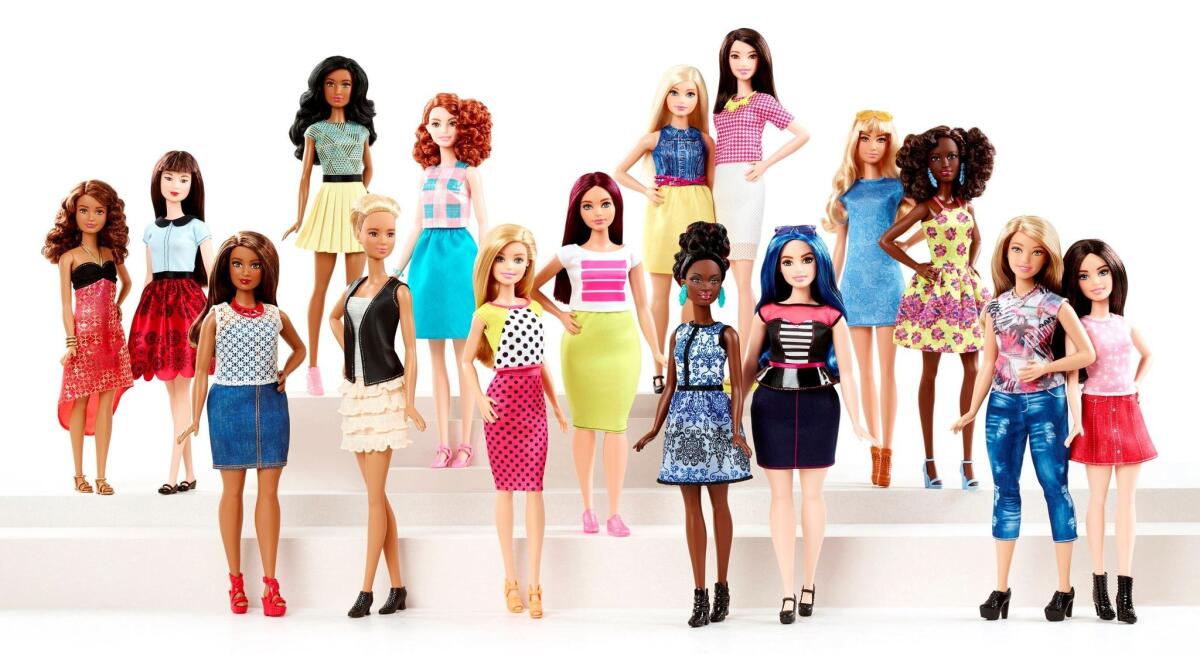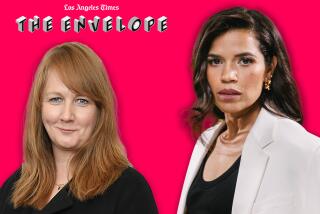Curvy or no, Barbie is still a mean girl

New Barbie dolls stand alongside older models in this Jan. 28 photo.
- Share via
Never mind the prospect of a woman in the White House. Last week saw what some are calling the most important feminist development of our time: Mattel’s release of “Curvy Barbie,” a doll whose wider hips and sturdier thighs are being held up as an antidote to the anatomically impossible proportions of traditional Barbie.
Curvy Barbie is actually part of a line of several new and supposedly more inclusive dolls that come in different skin colors and body types. But because the other body types are Petite Barbie and Tall Barbie, which are just regular Barbies plus or minus a few centimeters, it’s Curvy that’s the real story.
Unlike most children’s dolls, Barbie isn’t a source of comfort as much as an object of antagonism.
And the story varies depending on who’s telling it. A Time magazine reporter watched a group of children play with the new dolls; they identified Curvy as “fat.” Conservative commentators, ever on the lookout for politically correct overcorrections, chalked the whole thing up to liberal pandering, or even the rapid extinction of desirable women. Writing on Breitbart.com, the openly gay and reliably feminist-hating Milo Yiannopoulos wrote “every step fat-feminism takes toward victory means another wistful glance in my direction from otherwise-straight men.” (Uh, OK.)
Yet for some progressives, Curvy doesn’t go far enough. Writing in Bustle, Georgina Jones observed that even though the new dolls are “slightly larger and more racially diverse,” they still represent “a conventionally attractive woman.”
Jones is right, but she doesn’t go far enough. Whether we’re talking about looks, hobbies or taste in clothes, houses, cars, men, purses and a myriad other accessories, conventionality has always occupied the entirety of Barbie’s wheelhouse. And it’s a conventionality that’s imbued with a taunting, almost hostile quality: Barbie, and her stuff, in effect tells us “it sucks to be you.” Maybe that’s why, unlike most children’s dolls, Barbie isn’t a source of comfort as much as an object of antagonism.
Not to mention a frequent object of torture. A 2005 British study about how children interact with branded products concluded that Barbie was a “hate figure” among girls ages 7 to 11, who inflicted on the doll mutilations ranging from “removing the hair to decapitation, burning, breaking and even microwaving.”
“The girls almost always talked about having a box full of Barbies,” said the study leader, Agnes Nairn. “So, to them, Barbie has come to symbolize excess. Barbies are not special. They are disposable, and are thrown away and rejected.”
Iconic Barbie may be blonder, bluer-eyed, richer, thinner, leggier and bustier than everyone else, but she’s also “not special” and “disposable.” How can both be true at once? It’s simple. Barbie is not a child’s friend but her ultimate frenemy. She’s a mean girl. She is — and depending on your demographic this may be the worst epithet of all — basic.
In case you’re not familiar with “basic” as a disparagement, I’ll explain. Originally a hip-hop meme, the term has given rise to a phrase I won’t repeat in which “basic” is followed with another “b” word and used to describe a high-maintenance, trend-obsessed yet eternally bland young woman. This young woman is basic because she embraces the most obvious, mainstream aspects of consumer culture with no apparent interest in forming her own opinions. Commonly cited signifiers of basicness include being a fan of Taylor Swift, liking “Sex and the City,” having scented candles, talking incessantly about going to the gym, and ordering pumpkin-spiced lattes and Instagramming the barista’s foam design.
Barbie, I think we can all agree, is as basic as it gets. Impressively, she remains basic even in her myriad incarnations. Over the years, Mattel has offered her up as an astronaut, a pilot, a rock star, a surgeon, a business executive and any number of other Barbie-fiable archetypes (the surgical scrubs doubled as a mini-dress), but you can be sure that she still had “Shake It Off” blasting away in the operating room or a vanilla-scented candle in the crew cabin of the space station (“You guys, why can’t I light this?”).
We can also be pretty sure that the introduction of new Barbie body types, while not a bad thing, won’t really matter much. No matter what shape Barbie comes in, most little girls will probably care far more about the breakability of her neck than the size of her hips. Beheading Barbie, after all, is a beautifully basic rite of passage.
Twitter: @meghan_daum
Follow the Opinion section on Twitter @latimesopinion and Facebook
More to Read
A cure for the common opinion
Get thought-provoking perspectives with our weekly newsletter.
You may occasionally receive promotional content from the Los Angeles Times.










